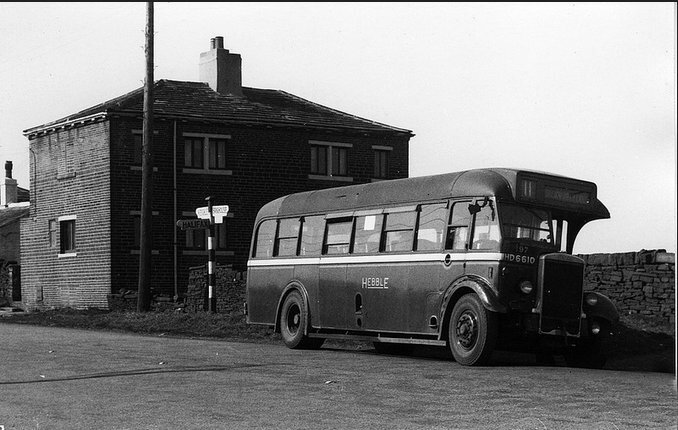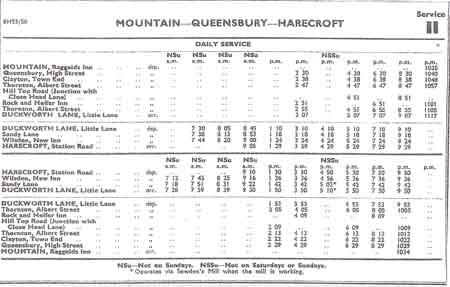THE CLAYTON FLYER
THE FOLLOWING INFORMATION HAS BEEN GIVEN TO OUR HISTORY GROUP BY
MR ALAN WHITRICK
This gesture is very much appreciated
The Queensbury Flyer
ROUTE 11, THE QUEENSBURY FLIER, (AND A MYSTERY SOLVED). I was recently talking to my friend’s father. He is 89, and during the last war his father was in the Home Guard. He was stationed at Yews Green, so decided to buy a house there. I was saying to John that Yews Green was, and still is, a difficult place to get to. His family used to walk to Queensbury Railway Station to catch a train. Yews Green is actually nearer to Queensbury Station than the station is to Queensbury. They had to put the station so far away from Queensbury so that it was near to the railway lines. “We also used to catch a Hebble bus to Clayton.” John said. I thought they walked up to the Raggalds Inn, at Mountain, to catch the Queensbury Flier. The inn is only a short distance from Yews Green. “No we didn’t catch that bus, there was one that came from Clayton, via Cockin Lane, and turned round by the gas lamp,” was John’s reply. I was astounded. I had never heard of a Hebble bus route to Yews Green. The only Hebble route I knew about was route 11. This route was known as the Queensbury Flyer, Clayton Flyer, or Thornton Flyer, depending on where you lived.
Leyland Tiger Number 197 HD 6610 with E.C.W Body. Bought from Yorkshire Woollen in 1950. Photo taken21/4/51 at the start of route 11 opposite the Raggles Inn
The Original Route
The original route started as a two-hourly service from Queensbury to Bingley, in 1926. The bus went via the Brown Cow Keelham, Thornton, Allerton and Cottingley.
It was a very rural route, going through some sparsely populated areas. By 1930 the route had changed to run hourly from Mountain to School Green, via Queensbury and Clayton. By November 1933 the route had been extended from School Green to Thornton. In October 1935 the route was extended yet again, from Thornton to Duckworth Lane, via Egypt, Harecroft and Wilsden.There was a bus from the Black Horse in Thornton, to the Rock & Heifer just as the schools were finishing. All the kids that lived up Back Heights used to catch it. The bus would not go until all the regular kids were on the bus.For most of its life the destination blinds always said Hare Croft and notHarecroft.
Why the Queensbury Flyer? Looking at the timetable the answer is obvious; the bus had eight minutes to get from Queensbury to Clayton!
As a child I used to visit a lady that lived in a group of cottages at Brow Top, halfway up Baldwin Lane. Mrs Lister used to look out of her scullery window, and she could see the Hebble coming through Scarlet Heights. We used to dash out of the cottage up to Baldwin Lane and catch the bus at a place called Sparrow Park. Thiswas a piece of grass about ten yards square, with a seat on it. We sometimes had to run as the bus came so fast down the road. The fair was 1d. to Clayton.We used to catch the bus to Queensbury, and then change to a Halifax Corp. busto Halifax. Halifax buses were not allowed to cross the Bradford boundary.
Leyland Royal Tiger Number 163 CJX64 entering Rhodesway 14/4/62
Further Research
I now needed to do some research on the bus route to Yews Green. I consulted Richard Gill, who is very knowledgeable on the Hebble Bus Company. He had no knowledge of a bus to Yews Green during the war. He was able to let me have a copy of the timetable for Hebble Route 10. This was the Clayton-Yews Green- Queensbury-Clayton (Circular). British Rail closed the Clayton, Queensbury, Thornton line to passengers in May 1955. They gave Hebble Motors a three year contract to run buses to Yews Green, as a railway replacement. This was Route 10, the bus that John used to catch. The route only ran on weekdays & Saturday. It was quite a complicated timetable. The first bus ran from Yews Green to School Green and back. The bus turned at the end of Brow Lane, (this was where the gas lamp was). The bus then went to Clayton via Cockin Lane and Gasworks Lane. After a 10 minute layover the bus went up to Queensbury. It turned right at the Stag’s Head, then right again, down Thornton Lane to Yews Green, then back to Clayton. There were no buses between 8:30 am and 4 pm. The route was slightly different again in the evening. This time the bus went from Clayton to Yews Green, and then back to Clayton via School Green. The next bus went to Yews Green via School Green, then to Clayton via Queensbury. The route was not well used,and stopped running in 1959. One lady, Muriel Kitchingman used to use the bus regularly. Her son, Ian, was in his pram at the time. One of the conductors wouldn’t let Muriel get on the bus with the pram, so she had to walk. Later Muriel worked at Fields Printers, at Lidget Green. She asked her boss if she could finish work a bit earlier, so that she could get up to Clayton in time to catch the bus to Yews Green. He said he couldn’t allow her to finish earlier, but would run her up to Clayton to catch the bus. One day the bus left early, so she missed it. Her boss took her all the way home. He didn’t realise how far she had to walk. He allowed her to finish earlier after that. I am indebted to Richard Gill for his information, and timetables, also to the people that lived in Yews Green that remembered the service. The photos were all taken by the late Jim Copland. I would be grateful if anyone that has any photos of buses on routes 10 or 11 would let me have a copy.
A.E.C Regal
Roe Body Number 11 JX9822
The Photo is Taken in Little Lane c1955
The Route until April 1951
This route continued until the 21St. April 1951, when Black Dyke Lane, in Egypt became unsafe, and the road was closed to vehicles. The road ran between two quarries. It was possible to stand at the side of the road and look straight down into the bottom of the quarries. There were only a few feet from the road to a sheer drop on either side.
The road that went through the Walls of Jericho, at Egypt, was too narrow for a bus to get through, so the route was changed once again.
The route now started outside the Raggalds Inn, at Mountain. It then went into Queensbury, and turned round by the parish church. The bus went through Scarlet Heights, down Baldwin Lane to Clayton Town End, via Clayton Lane. From Clayton the route went down Low Lane (known as Gasworks Lane locally) up Chat Hill, left at School Green into Thornton via Market Street, West Lane and then up Hill Top Road,turning right down Half Acre Lane, passing Jerusalem Farm and Moscow to the Rock & Heifer at Egypt. The bus turned here and retraced its steps to School Green.
Here it went down Thornton Road, on Rhodesway, to Duckworth Lane, standing in Little Lane. From here the route went via Sandy Lane to Wilsden, turning round by the New Inn, and going on to Harecroft, turning at Station Road in the village.
Because the route was so long the service was reduced to one every two hours. The service continued with slight modifications, most buses turned in Queensbury, with only the occasional bus going to Mountain. On the 3rd June 1966 the service was withdrawn altogether.
BELOW
Leyland Tiger 125 ACP725 taken in Clayton Lane December 1957.
The vehicle was withdrawn shortly after this photo was taken. Notice the state of the mud guards. The drivers often caugh field walls in narrow parts of thye route.
Route 11 was a friendly route, with regular crews. One of the conductors
was Mr Taylor. He lived next door to my mum and dad. Mum used to do her shopping in Clayton, and then give her bags to Mr Taylor. He would stop the bus in Clayton Lane and put the shopping over the wall into her garden! As such there were very few bus stop signs. People just seemed to know where the stops were. If you just put your hand out the bus would stop. There was always a stop outside a pub. The crews used to frequent the Raggalds Inn for a pint. Hebble crews were also allowed to use the toilets at Duckworth Lane depot.
TIME-TABLE MOUNTAIN TO HARECROFT ROUTE 11
Mountain to Wilsden






